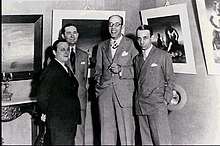Candido Portinari
| Cândido Torquato Portinari | |
|---|---|

|
|
| Born |
Cândido Portinari December 29, 1903 Brodowski, São Paulo, Brazil |
| Died | February 6, 1962 (aged 58) Rio de Janeiro, Brazil |
| Nationality | Brazilian |
| Known for | painter |
| Notable work | O Mulato, Café, Meninos de Brodowski, Guerra e Paz |
| Movement | Modern Art |
Cândido Portinari (December 29, 1903 – February 6, 1962) was one of the most important Brazilian painters as well as a prominent and influential practitioner of the neo-realism style in painting.
Portinari painted more than five thousand canvases, from small sketches to monumental works such as the Guerra e Paz panels, which were donated to the United Nations Headquarters in 1956. Portinari developed a strong social preoccupation throughout his oeuvre and maintained an active life in the Brazilian cultural and political worlds.
Born to Giovan Battista Portinari and Domenica Torquato, Italian immigrants from Chiampo, Veneto, in a coffee plantation near Brodowski, in São Paulo, Portinari studied at the Escola Nacional de Belas Artes (ENBA) in Rio de Janeiro. In 1928 he won a gold medal at the ENBA and a trip to Paris where he stayed until 1930, when he returned to Brazil.
The journey significantly influenced Portinari. After his return, Portinari began portraying the reality of Brazil, from its natural beauties to the harsh lives of the country's most impoverished populations, pursuing an amalgamation of his academic formation with the modernist avant-gardes. In 1939, Portinari exposed at the New York World's Fair. In the following year, Portinari had for the first time a canvas exposed at the Museum of Modern Art.The rise of fascism in Europe, the wars and the close contact with Brazilian problematic society, reaffirmed the social character of his work, as well as conducting him to political engagement.
He joined the Brazilian Communist Party and stood for deputy in 1945 and for senator in 1947, but had to flee for Uruguay due to the persecution of communists during the government of Eurico Gaspar Dutra. In 1951, the first São Paulo Art Biennial dedicated a special room for his works. He returned to Brazil in the following year, after a declaration of general amnesty from the government. In 1956, after the United Nations had appealed to its affiliated countries for the donation of a work of art to the organization's new headquarters. Brazil designated Portinari for the task, who took four years and around 180 studies to complete the painting. Dag Hammarskjold, UN Secretary-General, named the work "the most important monumental work of art donated to the UN".
...
Wikipedia
